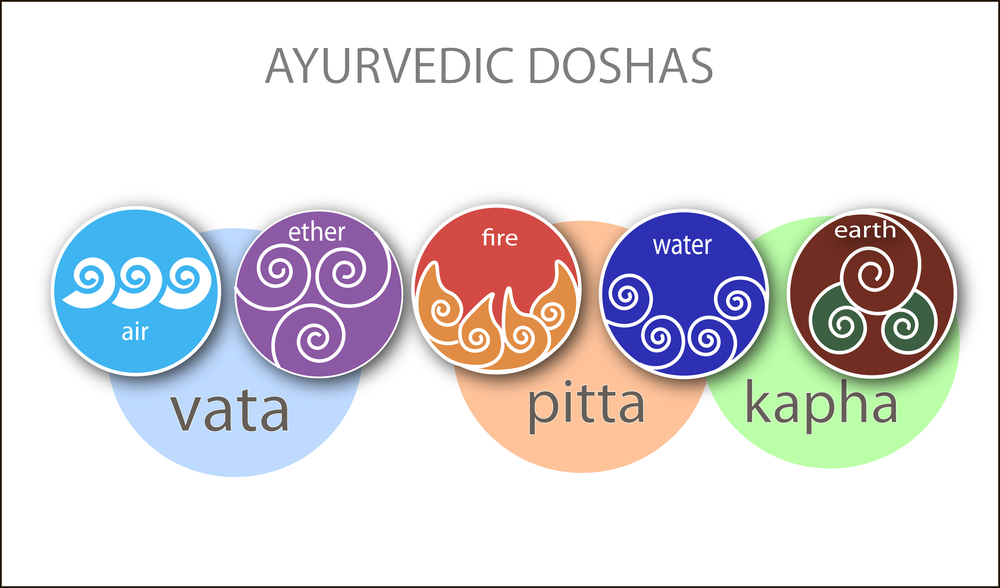In Ayurveda the three doshas (vata, pitta, kapha) are the three energies that live within our bodies and minds. Each Ayurvedic dosha has a different function, and a different way of helping us. The three doshas are called vata, pitta, kapha and in this post we’ll talk about each of the three doshas and how each of them works, and their charateristics within the body.
The three doshas (vata, pitta, kapha) are found in every body, but different people have different levels of each energy. Think of each dosha as an ingredient to your constitution. Every person has the same ingredients – but not the same measurements and quantities.
You can find out the constitution of your doshas (vata, pitta, kapha) by doing online dosha quizzes (we wrote about that here). This is the easiest and quickest way to find out roughly, which energies and doshas are most prominent in your body’s constitution. The online quizzes are a fantastic way to find out whether you are vata, pitta, kapha – and they’re usually free.
What are the three doshas called?
By name, the three doshas are; vata, pitta, kapha.
Finding the balance of vata, pitta, kapha within yourself, is key to living the balanced and harmonised lifestyle that Ayurveda helps you strive for. Knowing how your body is balanced between vata, pitta, kapha is key to understanding how to live.
Each dosha is made up of two (of the five) elements, so each of vata, pitta, kapha are made up of different elements. The elements according to Ayurveda are; air, earth, ether, fire, water.
You’ll notice below (when we break down each dosha) that they are each made up of two from this list. The elements have different characteristics, which effect us in different ways, and effect the way the work within our bodies. And it is the elements which give each dosha (vata, pitta, kapha) their different functions and characteristics.

Vata Dosha
The first of the doshas (vata, pitta, kapha) we’ll discuss is the Vata Dosha. The vata dosha is the dosha of movement. It’s contributing elements are air (movement) and ether (space). Here are some characteristics of the Vata dosha…
- The air element gives Vata mobility and dryness.
- The water element gives Vata lightness and subtlety.
- Vata is the force of all movement (such as circulation and nerve impulses) so it’s a crucial dosha for the body and mind.
The Vata dosha has many purposes in the body, some of which you’ve already read about above. Some of the other key functions of the Vata dosha are:
- Providing movement for elimination of waste
- Providing movement for breathing
- Providing all nervous system functions, and all sensation
- Igniting Agni
- Supporting memory in the mind
- Helping with understanding and ambition

Pitta Dosha
The next of the three doshas (vata, pitta, kapha), is Pitta dosha. Pitta dosha is the dosha of transformation, and it is made up of the fire element and the water element. Here are some of the main characteristics of the Pitta dosha…
- Pitta takes on the characteristics of fire and water.
- Pitta has the fluidity and oiliness from the water element.
- Pitta takes the sharpness and heat from the fire element.
- Pitta plays a big part in digestion and is found in the stomach and small intestine.
Pitta helps the body in many ways, but digestion is one of the key functions for Pitta in the body. However, here are some of the other ways the Pitta dosha helps the body to function:
- Producing blood to help the body function
- Providing sight
- Giving colour to the skin
- Giving you self-belief and self-confidence
- Helping with intelligence and learn abilities
- Digesting food and fuelling the agni within the body

Kapha dosha
The last of the three doshas (vata, pitta, kapha) is Kapha. Kapha is the dosha of substance, and it is made up of the earth element and the water element. Because of this, the Kapha dosha receives qualities such as oiliness, fluidity and smoothness from water, and heaviness and stability from the earth element.
Here is how Kapha helps the body:
- Kapha gives the body strength and substance.
- Kapha helps the body’s immunity and helps fight disease.
- Kapha helps with healing.
- Kapha provides the body’s taste sensations.
- Kapha stabalises and lubricates the body’s joints (like knees, elbows, hands)
- Kapha help digestion by providing moisture to food in the stomach.
You’ll find Kapha mainly in the stomach and the chest of your body, however it impacts many areas of the body, as you can above.

I hope this guide to the three doshas (vata, pitta, kapha) for beginners has given you a strong understanding of how each dosha works in the body, and what the properties of each dosha is. The three doshas of vata, pitta, kapha play a big part in Ayurveda, so it’s key to understand how each of vata, pitta, kapha work in your body.




